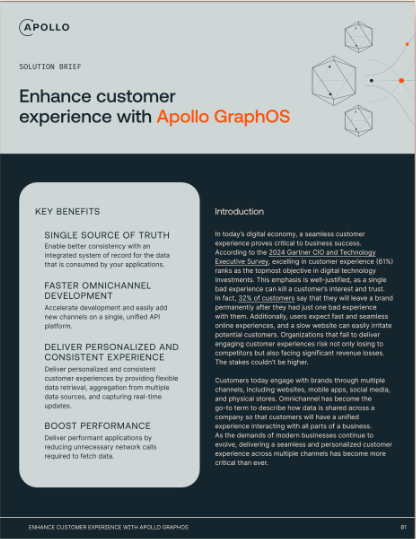Apollo Client 1.0: A flexible, community-focused JavaScript GraphQL client

Jonas Helfer
Today, we are proud to announce Apollo Client 1.0, “Pink Panther”! Apollo Client is now fully featured, stable and production-ready. If you’ve been holding off on trying GraphQL or Apollo, now’s a great time to check it out.

Apollo Client is a client-side library that leverages the power of a GraphQL API to handle data fetching and management for you, so that you can spend less time plumbing data and more on building your application.
Try it now with the interactive example on our home page.
The Apollo community
I’m absolutely amazed and humbled by how far Apollo Client has come since the project’s start a little over a year ago. We set out to build a modular and powerful GraphQL client that works with any view layer.
What we’ve achieved is much more than that: Not only have we built a fully-featured GraphQL client together with over 450 contributors, we’ve even advanced the state of GraphQL by working on new, cutting-edge features like subscriptions. And the GraphQL community is more exciting than ever before, with new tech released every day, and the next generation “Relay Modern” coming out soon.
Today Apollo Client has had over 3,000 commits, 2,000 stars on GitHub and 100,000 monthly downloads on npm. None of this would have been possible without an amazing open source community. We feel privileged to work with so many users and contributors from all over the world, including engineers from companies such as Airbnb, Coursera, CreditKarma, Google, the New York Times, OpenTable, Shopify and Zendesk.
Read on to find out what this amazing community has built together.
Apollo Client 1.0 in a nutshell:
- It works with any GraphQL server and schema.
- It’s easy to get started with, and extensively documented.
- It works seamlessly with your favorite React community tools like Redux and Recompose.
- It has integrations for Angular, Ember, Vue, Meteor, Next.js, and more.
- It has built-in tools for optimistic UI, SSR, pagination, loading state, and everything else you need to build an app.
- It supports GraphQL subscriptions out of the box.
- It gives you full control over your GraphQL store.
- It has its own Apollo Developer Tools to help you understand your app.
If you’ve been using Apollo Client since 0.x, make sure to read our guide on migrating to 1.0. We’ve also significantly improved the documentation, so even if you’ve read it before you might find something new.
Getting started with GraphQL
If you’re new to Apollo or GraphQL, you’re really going to like what we have to offer! Here are some great resources for getting started:
- Learngraphql.com: a course that teaches you the basics of GraphQL.
- GraphQL.org: the official GraphQL specification and documentation.
- Full-stack React + GraphQL tutorial: A short tutorial (by yours truly).
- Learnapollo.com: A longer tutorial built by the Graphcool community.
Once you’ve gotten an initial impression, reading the Apollo documentation is a great way to learn about the more advanced features of Apollo Client.
What’s next?
The 1.0 version number means Apollo Client is stable and being used in production apps around the world. As we’ve said before, reaching 1.0 doesn’t mean we’ll stop improving Apollo and adding new features — quite the opposite. We’re excited to start working with the community on next-generation features like cache invalidation, persistent offline caching, file upload handling, a streaming network interface, built-in prefetching and more, so stay tuned!
There’s still plenty of opportunity to join us in working on Apollo Client. If you have a few spare minutes every now and then, we’d love for you to join our community and become a contributor by joining our Slack channel and helping the project with issues and pull requests. Read our recent post to discover all of the ways to stay up to date with Apollo.
